Podcast
Questions and Answers
What is the typical size range of antisense oligonucleotides (ASOs)?
What is the typical size range of antisense oligonucleotides (ASOs)?
- 10 to 20 nucleotides
- 8 to 50 nucleotides (correct)
- 5 to 10 nucleotides
- 20 to 100 nucleotides
What is the main mechanism of RNAse H-dependent ASOs?
What is the main mechanism of RNAse H-dependent ASOs?
- mRNA degradation (correct)
- Modulation of the splicing process
- Inhibition of translation
- Blocking of microRNAs
What was modified in the first generation of ASOs?
What was modified in the first generation of ASOs?
- The ribose sugar
- The furanose ring
- The oxygen atom in the backbone (correct)
- The phosphate linkages
What is the result of the mutations in the DMD gene?
What is the result of the mutations in the DMD gene?
What is the goal of antisense oligonucleotides-based therapy for DMD?
What is the goal of antisense oligonucleotides-based therapy for DMD?
What type of disease is Duchenne muscular dystrophy?
What type of disease is Duchenne muscular dystrophy?
What is the main characteristic of Duchenne muscular dystrophy?
What is the main characteristic of Duchenne muscular dystrophy?
What is the function of RNAse H?
What is the function of RNAse H?
What is the main difference between the first and second generation of ASOs?
What is the main difference between the first and second generation of ASOs?
What is the outcome of the modifications made in the third generation of ASOs?
What is the outcome of the modifications made in the third generation of ASOs?
Flashcards are hidden until you start studying
Study Notes
Gene Therapy Strategies
- Gene augmentation: adding a new normal protein-coding gene to cells with non-functional gene
- Can be classified into two categories: gene replacement therapy and gene addition therapy
- Gene silencing: the use of DNA or gene editing technologies to enhance the function of a healthy person
- Examples: increased muscle mass, improved oxygen delivery, and accelerated recovery
Gene Doping
- The use of DNA or gene editing technologies to enhance the function of a healthy person
- Banned by the World Anti-Doping Agency (WADA) for non-therapeutic forms of genetic manipulation
- Examples: introducing genes that promote muscle growth, genes that encode for erythropoietin (EPO), and genes that promote tissue repair and regeneration
Gene Augmentation
- Gene replacement therapy: the delivery of a correct copy of the gene to restore the production of a defective or missing protein
- Example: Spinal Muscular Atrophy (SMA) gene replacement therapy
- Gene addition therapy: the delivery of a protein-coding gene to improve cellular function and homeostasis
- Example: autophagy gene addition therapy for neurodegenerative diseases
Gene Replacement Therapy
- Spinal Muscular Atrophy (SMA) is a group of genetic disorders characterized by the degeneration of anterior horn cells and subsequent muscle atrophy and weakness
- Caused by mutations in the SMN1 gene, which produces a functional protein essential for motor neuron development
- SMA patients have a non-functional SMN1 protein, and the only functional protein is produced by the SMN2 gene
- The number of copies of the SMN2 gene modifies the severity of the condition
- Example: Zolgensma, a gene replacement therapy for SMA, delivers a functional copy of the SMN1 gene to motor neuron cells
- FDA approved therapy with a marketing price of $2.125 million
Gene Addition Therapy
- Autophagy is a highly regulated cellular process that facilitates nutrient recycling and degrades damaged organelles and proteins
- Important in neurodegenerative diseases, where abnormal protein accumulation occurs
- Mechanisms of autophagy:
- Microautophagy: direct engulfment of cytosolic material through lysosomal invagination
- Chaperone-mediated autophagy: selective degradation pathway targeting proteins with recognition motifs
- Macroautophagy: formation of phagophore, autophagosome, and autolysosome to degrade cellular material
- Example: Machado-Joseph disease (MJD) or Spinocerebellar Ataxia Type 3 (SCA3), a polyglutamine disease caused by an unstable expansion of a CAG repeat sequence in the ATXN3 gene
- Upregulation of the autophagy pathway as a therapeutic strategy to clear mutant ataxin-3 and improve neuronal homeostasis
Gene Silencing
- Methods of gene silencing:
- Antisense oligonucleotides (ASOs)
- RNA interference (RNAi)
- Antisense oligonucleotides (ASOs):
- Synthetic, unmodified or chemically modified, single-stranded nucleic acid molecules that hybridize to their target mRNA
- Exert action through RNAse H-dependent or RNAse H-independent mechanisms
- Example: Duchenne muscular dystrophy (DMD), an X-linked recessive disease caused by mutations in the DMD gene, resulting in a prematurely truncated dystrophin protein
- Antisense oligonucleotides-based therapy for DMD
Studying That Suits You
Use AI to generate personalized quizzes and flashcards to suit your learning preferences.




